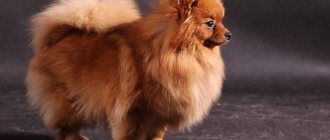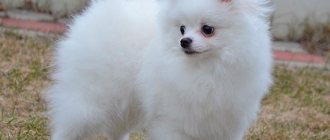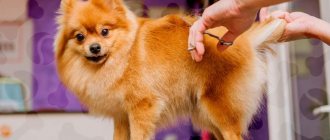If you have firmly decided to get a Spitz, you will be faced with the question: how to choose a healthy puppy and what to look for when choosing? To make the right choice, you should answer the main question: Why and for what purpose is a dog purchased? The answer to this question, firstly, will guide you on the cost of a Spitz, because the price of puppies varies and depends on the purpose of the dog, and secondly, it will help you understand what kind of life your pet and you will lead with it.
For exhibitions or “for the pillow”?
Let's figure out what classes Spitz are divided into. Depending on what fate is predicted for the puppy, Spitz dogs are divided into show class , breed class and pet class . Show class (from the English show - show) assumes that the puppy will participate in various exhibitions and competitions. Breed class puppies (from the English breed - breeding) are puppies intended for breeding. Representatives of these two classes are much more expensive than pet-class puppies (from the English pet - favorite pet), that is, pet dogs. Usually experienced, what this or that dog will grow up to be. But you cannot be 100% sure that a certain puppy will grow into a show winner. So, if you choose a puppy for exhibitions, it is always a risk, but do not be upset if your pet does not live up to your expectations, first of all, he gives you all his love and affection.
It is a big misconception to think that champions are born exclusively from champions. It all depends on you and your desire, because if your dog does not have any deviations from the standard, you monitor the quality of nutrition and health, and conduct educational work, then you can easily participate in exhibitions and count on offspring.
If you are going to purchase a show-class , it is advisable to choose a dog together with a competent person; invite a specialist dog handler from the club with you when going to the breeder. When choosing, pay attention to the origin of the parents (pedigree) of the selected puppy, as well as their appearance. If you are planning to buy a stud dog, it is advisable that it belongs to a “line mating” litter - this is a litter in which sires belonging to the same stud line are bred, whose exterior repeats the exterior of the ancestor.
If your puppy's father passed on his type to his offspring, there is a chance that your pet will become an improver like its father.
Well, if you just need a pet, there is no point in overpaying. It should be borne in mind that representatives of the pet class also grow into typical representatives of the Spitz breed, but in some respects they may not reach the breed standard, for example, they may have a straight bite instead of a scissor bite.
In any case, your pet will be devoted to you and will be able to give you many joyful moments.
When purchasing a Spitz, be sure to tell the breeder your preferences regarding the class, in this case he will be able to choose the most suitable puppy for you.
Tips from dog breeders
Experienced dog breeders who have managed to raise more than one generation of Pomeranians advise:
- Choose a seller carefully. Don't skimp on the price. The cost includes expenses incurred by the breeder. Check the dogs' living conditions in advance and make sure they are appropriate in order to choose a truly healthy family member.
- Don't get hung up on class and background. Sometimes prizes were taken by representatives with defects. Remember that although natural data is a significant advantage, the final image is formed by the proper care and concern of the owner.
- Check for vaccinations. Passive immunity is of course good, but disappears after the end of feeding. Remember that trying to choose a tiny baby will result in a tragedy for both the puppy and the owner.
- Don't be afraid of enclosure keeping. Contrary to popular belief, such conditions do not make dogs wild, but help protect them from indoor dangers.
- Do not try to retrain animals with behavior problems. Whatever the reason the breeder gives, do not believe in the ease of self-socialization of the Spitz. If an animal has a healthy psyche, then it will be the first to make contact, trying to please the person and receive praise.
Image by Valentin Simeonov from Pixabay
When you decide to choose a Spitz, try to adhere to these recommendations and carefully weigh in your head all the pros and cons of the breed.
Remember that to get an adequate pet, education and training are extremely important. Say a strict no to food “for as many as he eats, we give for as many.” Rapid weight gain in oranges is fraught with a number of concomitant diseases. It is necessary to build a diet correctly, focusing on fractional feeding of a certain calorie content.
Boy or girl? Choosing the gender of the Spitz
When choosing a dwarf Pomeranian Spitz, you should pay attention to the gender of the animal, and this issue also has its own nuances.
If you want to participate in exhibitions and win prizes, then the gender of the dog can play into your hands. Spitz males look more advantageous compared to females of the same breed: boys are much larger and stronger, their coat is longer, thicker, richer and more magnificent. Males, like true men, are stingy in showing feelings, although they can be gentle and affectionate.
But with male dogs, big problems can arise when raising them, because having a tough disposition, Spitz dogs will require considerable stubbornness and perseverance from you in order to achieve obedience from the Spitz. Males can initiate fights with other dogs, always trying to defend their owner and territory, they tend to dominate other, often larger, dogs. If a boy smells a bitch in heat while walking, he will rush to her, forgetting about everything in the world, and in the end he may run away and get lost.
As the male matures and physiology takes over, he will begin to raise his paw to mark territory. From now on, you will need to train your Pomeranian to go to the water bottle, and if you fail, keep in mind that then, like any other dog, you will have to walk your pet outside twice a day. And what’s even worse is that he will leave marks not only at your home, but also at a party.
Bitches , unlike males, are easy to raise, they have a soft and flexible character, and they do not have problems with the toilet. But girls also have their drawbacks, namely, troubles during estrus. Estrus occurs once or twice a year and lasts at least three weeks; during this period you need to keep your Spitz on a leash to prevent unwanted matings. To protect your furniture, carpets, blankets and other things from stains, you will need to wear panties on your pet during heat.
The next feature of bitches is pregnancy and lactation, which are accompanied by certain experiences, inconveniences and troubles.
If you want your pet to have offspring ( breeding class ), you should give preference to the simplest (and not the one with the show appearance) bitch in the litter, make sure that she is large and heavy enough, has a wide pelvis, and her movements are folding and balanced. Just as with males, it is also advisable to take a female from a “linear” litter. So that your Spitz girl can feed and raise healthy and strong offspring without any problems, look at her mother (ask the breeder): how expressed is her maternal instinct, how viable are the puppies produced, and also how many of them are in the litter (there should not be more than 4 puppies). If everything is in order with the mother, then all these qualities will be inherited by the Spitz girls.
But if you do not plan to have offspring, then your pet can live quietly without mating and offspring. It is a huge mistake to think that the risk of getting cancer is greater in those bitches who have not given birth than in those who have given birth. It is a myth. There is no scientific evidence for this assumption.
Key indicators when choosing
Experienced breeders spare no time and money to create their authority in certain circles. Therefore, such a dog owner always carefully looks after his pets.
Once in the nursery of the prospective seller, you need to pay special attention to important details:
- Nutrition. An experienced dog breeder does not skimp on animal nutrition, as he understands that it is necessary for the normal growth and development of pets.
- Cleanliness of the room. The puppies' habitat should be warm, dry and spacious.
If the basic requirements for keeping puppies are met, the proposed options can be considered.
Height (size) and weight of the dog
I have already talked a little about the size of the dwarf Spitz and the effect of growth on the ability to give birth, now I will make small clarifications. According to the standard, the height of a dwarf Spitz should be 18-22 cm at the withers. Spitzes with a height of 23cm or more fall into the next category - the category of small Spitzes. It happens that at an early age it is difficult to determine the future size of an adult dog. Therefore, if you are choosing a bitch with the goal of having offspring, this issue must be taken seriously. To avoid problems during childbirth (caesarean section, removal of tubes, death from anesthesia), you need to choose a large female at the upper limit of dwarf, that is, her height should be about 22 cm.
Male dogs also have their own characteristics. “For your pillow” you are free to choose a male dog of absolutely any height. But if you want to breed with your male, choose a smaller puppy, because for dwarf breeds the following mating rule applies: the male must always be smaller than the female.
Based on this, it is easy to conclude that breeders often breed small Spitz bitches with dwarf males; the litter from this mating is divided into two parts: some of the puppies born are small Spitz, and some are dwarf. But, despite this, all puppies will have “dwarf spitz” written in the breed column. Therefore, be sure to ask the breeder about the height of the puppy’s parents. But even if only dwarf Spitz were involved in the mating process, this does not guarantee that there will be no small Spitz in the litter. This is genetics, and it is impossible to predict in which litter this could happen. No one is immune from the case when a dwarf Spitz grows into a small one. An honest professional breeder will try to warn you about this in advance, and will write in the puppy card: “size review at 6 months.”
The weight of puppies at birth can range from 70 to 170 grams, and in small bitches the weight of puppies is usually more than one hundred grams. It also happens when born puppies weigh less than 70 grams (more often in dwarf Spitz dogs, as well as in small ones if there are dwarfs in their pedigrees) - this is not very good. Such babies may develop normally at first, but then at some point their growth is inhibited, and they especially often have large fontanelles. If your Spitz has an open fontanel, you need to closely monitor the dog and protect it from blows to the head.
Individuals less than 18 cm in height are extremely undesirable: such Spitz dogs have very thin bones, bulging eyes, ungrown fontanelles and a weak nervous system. Such dogs are not suitable for breeding, and they also do not participate in exhibitions. Even if you did not plan a show career, such dogs are also undesirable for a companion dog, because they have very poor health. If this does not scare you, and you decide to adopt such a small dog, start introducing your Spitz to other people and dogs as early as possible, because socialization in small Spitzes takes much longer than in normal-sized Spitz dogs. In addition to increased attention to health, small Spitz dogs need high-quality, balanced nutrition, as well as a strict eating regimen.
Documentation
When selling a puppy, the breeder must provide a puppy card and a veterinary passport containing vaccination records. If a Pomeranian Spitz puppy is purchased abroad, then the international veterinary passport must contain notes on three vaccinations, as well as a rabies vaccination. Before the sale, the puppy should have already been dewormed. You should check for the presence of a stamp.
A few simple tips on how to choose a Spitz
German Spitz are amazing small, seemingly defenseless dogs that are great for people who love an active lifestyle. They belong to the dwarf breed. Spitz are friendly and have a cheerful disposition.
What color to choose a Spitz?
The standard provides for 5 main colors of Pomeranian Spitz - black, white, orange, zone-gray, as well as many shades of these colors. The breed standard describes in great detail what a Spitz of a particular color should look like. You are free to choose any color you like.
I want to make the only reservation - at a young age it is very difficult to determine the future color of a puppy, especially if it is red (orange). If the breeder has managed to gain your trust, try to rely on him in this matter. You can also try to determine the future color of the Pomeranian yourself: look at the fur behind the ears, part the puppy’s fur on the back - if orange is visible from under it, then this is the color the adult Spitz will be.
Features of the puppy
In order to make the right choice, there are several general rules for all types of this breed:
- You need to concentrate on the puppy you immediately liked.
- It is worth taking a closer look at the behavior of a potential pet. Ignore the puppies hiding behind their mother. Your pet should not be afraid to approach its future owner. Take the puppy in your arms and watch his reaction. He should not break out and show aggression.
- You should carefully examine the puppy to determine its health condition.
It is also necessary to find out whether the puppy can feed on its own, otherwise there is a chance of ruining the pet’s stomach.
At what age should I buy a dwarf Spitz?
Any good breeder will not sell puppies younger than two, and ideally three months. If they are trying to sell you a very tiny puppy, spare him and yourself. Under no circumstances should you adopt such young individuals, firstly, because this is dangerous for the mental health of the dog, and secondly, by this time the puppies have not yet been activated, that is, they do not have puppy cards - at this age puppies are very weak immunity, and the risk of disease is extremely high. The older the puppy, the clearer how he will grow up.
When buying a puppy, pay attention to whether he knows how to eat on his own, otherwise there is a chance that the puppy’s intestines will rupture, which can lead to illness and, in extreme cases, death. This can happen because in toy breeds, even the slightest intestinal upset causes severe dehydration.
If you take a small Spitz puppy, you will have to do a lot of work to raise it, and the fruits of your efforts will not always be visible, because everyone makes mistakes. I say this in order to dispel the myth that it is better to take small puppies. This is completely optional. You should not be afraid to take on grown-up or already fully grown representatives of this breed. At this age, you can clearly see the height and height of all the dogs, their color, teeth, and most importantly, their character and disposition. You are insured against any surprises that may await you while your Spitz is growing up. An adult dwarf Pomeranian Spitz will very quickly get used to a new place and fall in love with its new owner, if he, in turn, devotes his love, affection and time to him.
If a breeder has one puppy left from any litter, do not think that he was not bought because he is the worst. Not only do people choose their Spitz, but Spitz also choose their owner. They just haven't met yet.
Who to buy from
For whatever purpose you decide to purchase a Pomeranian Spitz puppy, you should buy it either in a specialized nursery or from an experienced, well-established breeder.
Nowadays, a huge number of pet stores or resellers have appeared, which are driven only by the thirst for profit. Because of this, they have a huge selection of Pomeranian puppies of dubious origin, completely unsuitable for the standard of this breed. The surest indicator that you are being deceived is a low price of ten to fifteen thousand, because a true Pomeranian costs much more.
Accordingly, if you want to buy a real Pomeranian puppy, then you don’t need to save money and take the first baby you come across. It is better to spend your precious time looking for a pet from specialists. They will always help you not only with choosing a Pomeranian, but also tell you about his parents and genealogical origin.
No pedigree
Dogs without a pedigree are barred from future participation in exhibitions. If you just want to cheaply buy a good companion and a loyal family member, then you can safely take such a dog, the main thing is to see if it has any flaws.
Such dogs are not sold in kennels; every puppy there must have a pedigree.
Table 3. Prices for second hand puppies without pedigree
| Breed | Cost, thousand rubles. |
| Pomeranian | 10-25 |
| Wolfspitz | 15-20 |
| Japanese | 15-30 |
| Finnish | 10-25 |
| German | 10 |
| Greenland dog | 5 |
| Karelian bear husky | 15 |
Number of newborns
Caring for a toy breed dog is especially important during pregnancy.
Pomeranians have long been domesticated, so the period when puppies are born is especially important for them - at this time the females are extremely vulnerable.
Spitz bear their cubs for an average of 63 - 64 days. However, you need to be careful already on day 58. A dog gives birth to one to three puppies. A dog's small body is not designed to carry more puppies.
Price
The price of Spitz puppies depends on where to buy, what kind of exterior they have, color, class, and whether they are a boy or a girl. Using the example of the Pomeranian Spitz, you can consider what prices exist for this breed.
If you buy Spitz puppies through a nursery, prices will start from 40,000 rubles. up to 150,000 rub. Only Breed and Show classes are sold here, that is, aimed at participating in exhibitions.
If you buy secondhand, the price will fluctuate in lower limits - from 10,000 rubles. up to 45,000 rub. There are all classes to choose from: from Pet to Show.
Table 1. Cost according to advertisements
| Class | Cost, thousand rubles. |
| Pet class | 10 |
| Breed class | 35 |
| Show class | 45 |
Wool
Dog fur does not require serious care, as it might seem at first glance.
However, a puppy must be trained to use a brush from a young age.
Because brushing will be necessary during shedding.
It is also recommended to bathe animals no more than once or once a month and a half, since even specialized shampoos upset the balance of the skin.
The dog has a very thick undercoat, and if you decide to give the puppy a bath, you only need to dry it with a hairdryer. The thick undercoat will take a very long time to dry, and the dog may become hypothermic and get sick.
It is best to wipe the paws with a wet rag after a walk and comb them with a wet brush in the direction of fur growth and against it.
Recently, the services of a groomer have been gaining popularity - the fur of decorative dogs is trimmed and shaped.
This will keep the dog in neat condition, but it is also worth teaching it to grooming from puppyhood. Grooming an adult dog for the first time will be a real stress for him.
Feeding
It is better to feed a puppy under the age of 7 - 8 months 3 - 4 times a day.
Preferably at the same time.
It is better to use specialized food and diversify the dog’s diet with boiled meat and cottage cheese.
You should not give your animal fatty foods, pasta, or sweets. If you are going to give your pet a treat, it is better to use low-fat cheese and ready-made treats.
With pedigree
A dog with a pedigree is valued more, since a lot is known about their parents, and you can predict how they will grow up, what their character will be, and whether there will be genetic diseases. You can predict how a dog will grow up based on its pedigree.
In kennels, all dogs are sold with a pedigree. If taken from hand, the pedigree may or may not be present.
Table 2. Price for puppies with pedigree
| Breed | Cost, thousand rubles. |
| Pomeranian | 35-45 |
| Wolfspitz 559 | 25-40 |
| Japanese | 30-50 |
| Finnish | 25-30 |
| German | 15-20 |
| Greenland dog | 15 |
| Karelian bear husky | 30 |











